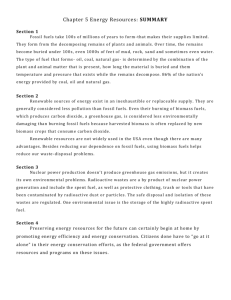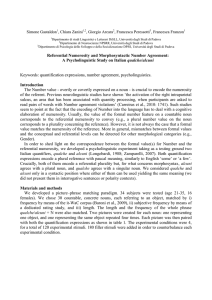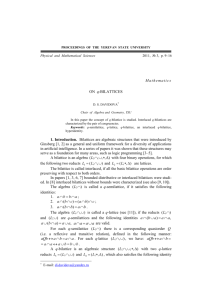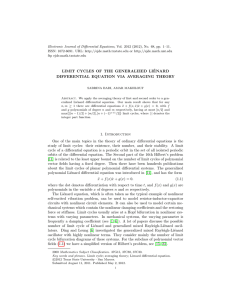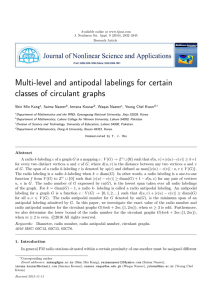Document 10442553
advertisement
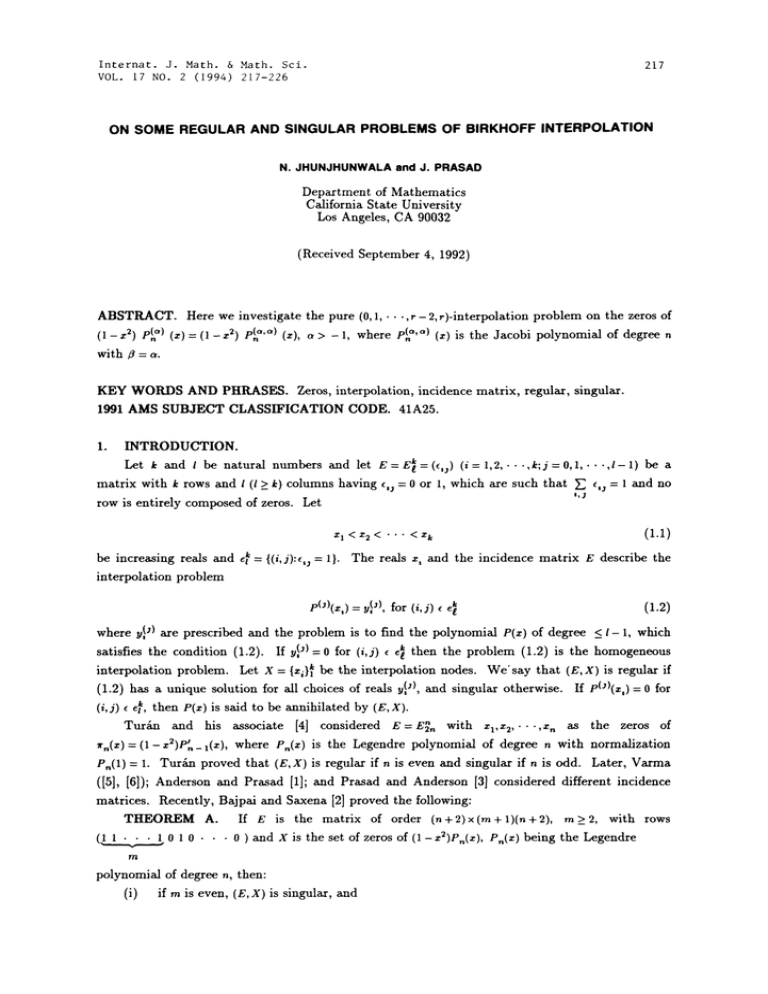
Internat. J. Math. & Math. Sci.
VOL. 17 NO. 2 (1994) 217-226
217
ON SOME REGULAR AND SINGULAR PROBLEMS OF BIRKHOFF INTERPOLATION
N. JHUNJHUNWALA and J. PRASAD
Department of Mathematics
California State University
Los Angeles, CA 90032
(Received September 4, 1992)
ABSTRACT. Here
(1- z 2)
with Z
P(,’)
investigate the pure (0,1,...,r- 2, r)-interpolation problem on the zeros of
(z)= (1- z 2) P"’’) (z), a > -1, where P(,"") (z) is the Jacobi polynomial of degree n
we
a.
KEY WORDS AND PHRASES. Zeros, interpolation, incidence matrix, regular, singular.
1991 AMS SUBJECT CLASSIFICATION CODE. 41A25.
1.
INTRODUCTION.
Let k and be natural numbers and let
E=E=(%)
matrix with k rows and (i >_ t) columns having e,j
row is entirely composed of zeros. Let
z
be increasing reals and
interpolation problem
e
(i=1,2,...,k;j-O, 1,...,l-1) be a
0 or 1, which are
such that
e,j
and no
"
<z<
(1.1)
< z,
{(i,j):Q- 1}. The reals x, and the incidence matrix E describe the
P(D(x,) y!’),
for (i,j)
e
(1.2)
where y!J) are prescribed and the problem is to find the polynomial P(x) of degree _< l-1, which
then the problem (1.2) is the homogeneous
satisfies the condition (1.2). If y!J)=0 for (i,j)
interpolation problem. Let X {xi} be the interpolation nodes. We’say that (E,X) is regular if
(1.2) has a unique solution for all choices of reals y!), and singular otherwise. If P()(x,)= 0 for
then p(x) is said to be annihilated by (E,X).
(i,j)
TurAn and his associate [4] considered E=E, with xl,x,...,x, as the zeros of
,(x) (1-x)P_l(x), where P,(x) is the Legendre polynomial of degree n with normalization
P,(1) 1. TurAn proved that (E,X) is regular if n is even and singular if n is odd. Later, Varma
([5], [6]); Anderson and Prasad [1]; and erasad and Anderson [3] considered different incidence
matrices. Recently, Bajpai and Saxena [2] proved the following:
TttEOREM A. If E is the matrix of order (n+2)(m+ 1)(n+2), rn_> 2, with rows
0 and X is the set of zeros of (1- x)P,(x), P,(z) being the Legendre
0 0
(.1
e
e,
polynomial of degree n, then:
(i) if rn is even, (E,X) is singular, and
218
N. JHUNJHUNWALA AND J. PRASAD
(ii) if m is odd, (E,X) is regular if n is even and singular if n is odd.
Let X be the set of the zeros {zk} +1 of (1-z 2) p) ()= (1-2) P{."’") (z),
p(.’a)(z) is the Jacobi polynomial of degree n with B a, such that
> -1, where
<Zl <z0= 1.
--l=Zn+l<Zn<
Our aim here is to prove the following:
THEOREM 1. Let X be the set of the zeros of (1- r2)P(.")(r),c, >
matrix given by
0
(1)m 0
0
(1)m 0
E
a
1,
and E be the incidence
0
0
En+) x (m + 1)(, + )
(1.3)
(1)m
0
0
0
where (I), means m entries of in that row. Let m be an odd positive integer _>3, and
< a < 1, then:
(i) if n is odd then (E,X) is singular.
m-2 and a is such that m-I--a(m 2) is
odd positive integer then
(ii) if n is even, a # -’V’’
+
for
is
all
and
other
values
of
is
m(E,X) singular
-a(m + 2), (E,X) regular.
(iii) if n is even and a m-2 then (E,X) is singular.
THEOREM 2. Let X be the set of the zeros of (I- t)P{na)(t),a > -I, and E be the incidence
matrix given by (1.1). Let m be an even positive integer >_ 2, and
< a < I, then:
(i) If n is odd then (E,X) is singular.
m- 2
(ii) If n is even and a -’V-’
(0 < a < I), then (E,X) is singular.
m-2
a
and
then (E,X) is singular if m-l-a(m+2) is an odd positive
is
even
If
n
(iii)
#
integer and regular otherwise.
2. SOME LEMMAS.
Here we state and prove a few lemmas.
LEMMA 1. If w.(z) e")(z),a > 1,A,(z) [(1 z2)w(z)]’,r 1,2,. and {zk} are the zeros
of wn(z then:
----,
--,
[." ()]’__.
(2)
(2.1)
I )1
2r+l)
=2r(2r/l)!(a/l)k(1-i)
[w2n’()==k
(+)
9 (,)=
A(" + ) (zt)
The prf is obvious.
LEnA 2. Let 2,(z)
Then:
,
[w(k)] 2r
( + ) (; )- [w"
0, i=0, 1,’’’, 2r-I
(;_ ), () [;
2r
(2r + I)
zt
(I
(,)],,
i=
zl)’- [W (Zk)12r
2r(2r 1)zk(l zi)- l2r)(Zk).
(I
2)2r (2_ i)2r,
()=
r
l,
,.
f0,s(2r):0,2r,1,...,
2
,
2r
2,-
(2.2)
(2.3)
(2.4)
-
REGULAR AND SINGULAR PROBLEMS OF BIRKHOFF INTERPOLATION
(12rr 4" I) (1)= 2 2r (2r
and
I)
219
(2rr 4" I) (_ I)
r
(2.6)
(2.7)
(2r+l)2rr) (-I).
2rr+’) (-I)=
(2.8)
The proof is obvious.
LEMMA 3. Let F,,(:)=[(I-z2)w,,(z)]"q,,+(x) be a polynomial of degree < (n+2)(m+ l)-l,
where q, + l(X) is a polynomial of degree s n + I, and let
F(nre+l) (zk)--0,k--0,1,2,-..,n+ 1.
Then, q,, + () satisfies the following conditions:
(1-z) q’+l(zk)+ra(a-1) x k qn+l(xk)-0,
2q+ (1)+m
2q+ (-1)-m
PROOF. Let
n( n + 2tr + 1)
l+a
1]
+ 1] q,,+,(-
+ q,,+l(1)
(2.10)
0
1)
(2.11)
0.
Then
2r.
m
n( n + 2 + 1)
(2.9)
k- 1, 2,...,n; tr> -1,
Fn(z
Ar(z)[(l- z2)rqn + l(Z)]"
On using Leibnitz’s formula and Lemma one can easily see that for
1,2,...,n,
k
F(n2r+l) (k)--(2r + 1)A!2r) (xk)(1-x) r-1 [(1-x) q+ (xk)+2rxk((--1)qn+
To evaluate F(,,2r + 1)( 4-1) we proceed as follows:
(2.12)
Fn(x>-2r(X>{[wn(x)]2rqn+l(X>}
Now, making use of Leibnitz formula and Lemma 2, we get
2rr + 1)(1)[wn(1)]atq, + 1(1) +
F(2r + 1)(1
+
(2r +2rl:rr)( 2r[w,(1)]:r
lw’(1)q) + l(1) + [wn(1)]2r q’ +
l(1)l.
(2.13)
We know that
(1
za)w(x)- 2(a + 1)rw(:) + n(n + 2c) + 1)w,(z)
(2.14)
0
hence
So, from (2.13) and (2.15)it follows that
F(.r+
2a’- l(2r +
1)![w,(1)]arl2q’+ i(I)+ 2I + n(n + + 1).
2a
l+a
n+ 1(1)
}
(2.16)
We also know that
w.( I)
l)nw.(1),
(2.17)
220
N. JHUNJHUNWALA AND J. PRASAD
)" +
to;,( x)
Further, using Leibnitz formula, Lemma 2, (2.17) and (2.18)
F(+l(-1)=2’-(2r+l)![w.(1)]
Next, let
m
2r + 1.
We
q+l(-1)- 1-t-
easily verify that
one can
n+l(-l)
1+
now write
:2)r + lwn(r)qn + i(:)]"
Fn(:) ,r(z)[(
Again, on using Leibnitz formula, Lemma
F(nr + 2) (zk)
and (2.14), it follows that for/
1,2,...,,,
zk)rw’n (:k) 2r) (:k) [(1 z) q +
(2r + 1) (2r + 2) (1
+(2r + 1)(a-- 1)zkqn +
Further,
(2.19)
to compute F(nr + 2)
(2.20)
+ 1), we write
(a:)q + 1(:)
,to
and use Leibnitz formula to get
2r+2(2r
E ? 2) ’) (:)[(I
--.b"(2r + I)():
i=0
l()](2r + I-,).
: 2.,ton2+ l(x)q. +
(2.21)
On simplification using Lemma 2, (2.21) yields
+ 2)(1)
2r+l(1)[2q’n+l(1)+(2r+l){
(2r+2), 22r wn
[
g’(2+)(-1) (-1)"(2r+2) ’"2r
.z to 2+ 1(_1 2q+1(_l)_(2r+l)
n(n+2+l)
tr+
{
+
n(n+2tr+l)
or+
1} 1(1)],
+ 1}
1(-1)1.
q, +
qn +
(2.22)
(2.23)
Hence the conditions
F (’+l)(k)=0, k=0, 1, 2,..., n+l
along with (2.12), (2.16), (2.19), (2.20), (2.22) and (2.23)imply (2.9), (2.10) and (2.11) for m even
or odd. This completes the proof of Lemma 3.
LEMMA 4. Let q,, + l(r) be a polynomial of degree _< n + which satisfies the following n + 2
conditions:
(1 z)q, + l(zk) + m(a 1)rtq,, + l(xk)
0, k
1,2,.
.,n;a
1] q,+ 1(1)=
n( + + 1)
2q+1(- 1)-m
+ 1] qn+ 1(- 1)=
+or
+ 2o + 1) +
2q + 1(1) + m
1,
2tr
(2.24)
(2.25)
0,
+tr
n
>
0.
(2.26)
Then q, + l(x) satisfies the following equation:
(I x2)
q + l(Z) -I- rn(- I) qn + I() c[ :2 LX(c)] wn(x),
where c is an arbitrary constant and
:()
}l+(r +1] (n+ +ntr)-l]
n(n+2+l)+a+lI(n+n)m(ls--a)-+2
I,
2
1-(r
n(n+2+l+trl)+tr+l n+ntr) m(l-tr)+21_a
+I
2(n+n )+1
(2.27)
REGULAR AND SINGULAR PROBLEMS OF BIRKHOFF INTERPOLATION
PROOF. Due
to
(2.24),
221
it follows that
(2.29)
x2)q;, + l(x) + "( )q, + 1() c2 + d +
constants. From (2.29), (2.15) and (2.17) we see that
(1
where
c, d
and are
(2.30)
(2.31)
--)n(t- 1)qn + 1(- 1)= (c-d +e)(- 1)
Also,
on differentiating
(2.29)
we
have
(1 x2)q + l(x) + [m(a 1)- 2]xq + 1() + m(a
1)q + l(X)
(2.32)
(cx + dx + e)w(x) + (2cx + d)wn(x ).
Hence, from (2.32)
we
conclude that
[m(a 1) 2]q + l(1 + m(a 1)qn + l(1)
[m(a 1) 2]q + l(
+ m(a 1)q. + ( 1) (c
(c + d + e)w(1 + (2c + d)wn( ),
1) +
d + e)w’n(
2c + d)w,(
1).
(2.33)
(2.34)
Further, from (2.30), (2.31), (2.15), (2.17), (2.18), (2.33) and (2.34)it follows that
Ira(a-1)-21
+2+)
<.+,(1)=(_)t"++(c++>. .(.2(+
)
(2.35)
(2.36)
Consequently, on substituting the values of qn+ l(1), q + 1(1), qn+ 1(--1) and q,+ 1(- 1) from the
above equations into (2.25) and (2.26) and simplifying we get
o)_
o)+
a
=0,
(2.37)
1] [(" +n a){m + _-}+ 1]:0.
(2.38)
+
+a
m+
+
o)+
+ (c
Now, from (2.37) and (2.38)
d + e)
+ 2a
L
l+a
we see
that d
+a
wch,
+
0
and
[
f=
+
0
on simplification, yields
c
(2.39)
222
N. JHUNJHUNWALA AND J. PRASAD
or, using
(2.28)
have
we
(2.40)
A(a)c.
This completes the proof of Lemma 4.
3. PROOF OF THEOREM 1 AND THEOREM 2.
Let E be the incidence matrix given by (1.3) and let X be the set of zeros of
(1 x2)P()(x) (1 x2)w,(x). Let F,(x) be a polynomial of degree _< (, + 2)(m + 1)- annihilated
by (E,X). We have to ascertain if F,(z) is identically zero. Since
Fn(x:)
F(x:)
F’(xk)
F( l)(xk)
rn(x
[(1 z2)w.(z)lmq. + ,(x),
O, k
O, l,
.,
+ 1,
where q. + () is a polynomial of degree < n + 1. Further, since we have required that
F(m+l)(xt)=O,
on account of
k=0, 1,’’., n+l,
Lemma 4, q, + (z) satisfies the following equation:
(1 g2)q + I(X)._ DI(- l)gqn +
(3.1)
C[ Z2 A()]wn(g)’
where c is a numerical constant. Let
n+l
_
q. + ()
(3.2)
().
k=0
Further, it is well-known that
x2)w’,(x)
(1
(3.3)
nxw,(x) + (n + a)w,_ ,().
Now, from (3.1), (3.2) and (3.3), on simple computations, it follows that
n+2
k(t +
k=l
[m(-a)-+] (+)(+2- )
o
2 ilk+ l(k+(+l)
k=0
+
Also,
we
1+
m(- 1)-k2k + 2tr + 3
1] w(x)
c[x 2- A(c)lwn(z ).
(3.4)
know that
(n+ 1)(n + 2a + 1)
(n+O
xwn(x)-(2n/2o+ l)(n/tr/ l) wn+l(x)+ (2n+2tr+ l) Wg
Repeated application of (3.5) in (3.4),
k=0
+2
’-
/:=1
Aw
where
simplification, yields
[rn(a I)- t + 1]k(k + 2tr)
(+.) (+.-I)
2(z) + Bwn(x) + Cw +
(n + o- 1)
a (2n (n+a)
c,
+ 2ct + 1) (2n + 2tr- 1)
B--
(3.5)
(k+o+l)[k+o(m+2)+2-m]
(2k + 2tr + 3)
ak +
n
+
on
1().
(n+ 1) (n+2tr + 1)
n(n + 2tr)
(2n+2+1) (2n+2a+3) + (2n + 2(r + 1) (2n + 2c- 1)
(3.6)
(3.7)
(3.8)
REGULAR AND SINGULAR PROBLEMS OF BIRKHOFF INTERPOLATION
223
{n+ 1) (n +2o + 1) (n+2) (n+2a + 2)
C=
(3.9)
Consequently, we obtain
(1 + ) [(m + 2) + 2
O,
a,
2a + 3
(k+l+cr)[k+ot(m+2)+2-m]
k(k+2oO[m(c-l)-k+l
at + + (k + ct) (2k + 2a 1)
at
(2k + 2or + 3)
k= 1,2,-
(. +
.,n-4, n-3,
i) [. + (, + 2) ,l
[m(a 1)
+ 3l (n 2) (n + 2c, 2)
an-’ +
(2k + 2or- 1)
(n+tr-2) (2n +2cr-5)
(n 4- c)
In 4- c,(m 4- 2) 4-
l a,+ [rn(c 1)
n 4- 21 (n 1) (n 4- 2 1)
(-+-l)(2- + 2,- 3)
(2n + 2tr + I)
(. +or + I) [n + ( + 2) + 2- ]
(2n + 2a + 3)
(n + 2or 4- 1) (n 4- 1) [m(c I) n]
(n +ct+ 1) (2n +2at + 1)
an + +
0,
(n + a) (2n + 2c 1)
._
a,
A,
an_3
0,
B,
an-O’
and
(.+2) (n+2a+2)[re(a- 1)-.- I]
(- +, + 2) (2- + 2, + 3)
Let
(i)
rn
.+
be an odd positive integer _> 3:
If n is odd, -1 < a < 1, and a is such that m-1-a(m+ 2) is
an even positive
integer
then
an
an-2
aO
a2
a3
0
a
and
am
3
O
ot(m +
but am_l_a(m+),am+]_,(m+2),....,an+ are note necessarily zero. Hence, qn+l(z) is not
identically zero. If n is odd, -1 < a < 1, and a is such that m-1-a(m + 2) is an even negative
integer then
an an-
0
a
a3
and a0,%,...,an_ 3 are not necessarily zero. Hence, qn+ i(z) is not identically zero.
If n is odd,
< tr < 1, and a is such that rn- -a(m + 2) is an odd integer or a fraction then
an:an-2--
:a3--al :0
but ao, a2,...,an_3,an_ and an+ are not all zero. Hence, qn+ () is not identically zero.
So, it follows that (E,X) is singular if n is odd.
< a < 1, a # m-2 and a is such that m-1-a(m + 2) is an odd positive
(ii) If n is even,
integer then
---,
an anand
a
a0
0
224
N. JHUNJHUNWALA AND J. PRASAD
=am_3_o(m+2)----0,
a l-a 3=
but am_]_(m+2),am+]_(m+2),...,an+l are not necessarily zero. Hence, qn+l(z) is not
is such that m-1-(m+ 2) is an odd
identically zero. If n is even, -l < a < I, a # m-2
negative integer then
-----,
an=an_
Noting that
al
a
0 we
conclude that
an- 3
a3
O.
Recalling the equations for
easil verified that c
n
is even,
an-2
a
a3
and a + and substituting the values of A, B, and C it can be
and a +l are also zero. Hence, qn + l(z) is identically zero. If
m- 2 and a is such that m-a(m + 2) is an even positive integer then
a
So,
0.
a
---,
< a < l,a
an
aO =0.
a2
a2
ao
0
and
an_ 3
O.
an+
an_
Hence, qn + (z) is identically zero.
If n is even,
then
< a < 1, a # m-2 and
----,
an an-
a
a0
a
is such that m-1-a(m + 2) is an even negative integer
0
and
al
a3
an
3
an
an +
O.
Hence, qn + (z) is identically zero.
If n is even,
m- 2 and
# -%-,
< < 1,
a
is such that
m-
-(m + 2) is a fraction then
=a2=a0=0
an=an_2--
and
al
a3
an- 3 an-
an +
O.
q,, + (z) is identically zero. Consequently, if n is even,
< a < 1, a # m-2 andaissuch
that m-1-a(m+2) is an odd positive integer then (E,X) is singular and for all other values of
rn
a(rn + 2), (E, X) is regular.
(iii) If n is even, a m- 2 and a is such that rn- -a(m + 2) iS a negative integer then
----,
Hence,
-----,
=a2=ao=0
an=an_2
and a1, %,-.-, an_ 3 are not necessarily zero. Hence, q, + (z) is not identically zero.
If n is even, a m 2 and a is such that m- -a(m + 2) is an odd positive integer then
---,
an an-
a2
ao
0
and
al
a3
am- 3- a(m + 2)
0
REGULAR AND SINGULAR PROBLEMS OF BIRKHOFF INTERPOLATION
225
but am_ -o(m + 2)’ am + -o(m + 2)’
"’ an- are not necessarily zero. Hence, qn + 1(x) is not
m-2 and a is such that m-1-a(m+2) is an even positive
identically zero. If n is even,
integer then
an anand
aO
a2
al,aa,...,a,,_ 3 are
0
not necessarily zero. Hence, qn + 1(z) is not identically zero.
Consequently, in this case, (E,X) is singular.
This completes the proof of Theorem 1.
Next, let m be an even positive integer _> 2, and
(i) If n is odd then
an an-2
< a < 1:
:a3:al =0
but not all %,%,...,a,+ are zero. Hence, q,,+ l(z) is not identically zero. So, (E,X) is singular.
m-2 < a < 1, then
(ii) If n is even and a --,0
tln
an-
but a,
ti2
a3,...,a_ 3
tiO
0
are not
Consequently, (E,X) is singular.
m- 2 and
(iii) If n is even,
an an-
a
a0
Hence q,+(z) is not identically
necessarily zero.
a
is such that
m-
zero.
-a(m + 2) is an odd positive integer then
0
and
a
a3
am_3_(m+2)
O,
but am_l_t(m+2), am+l_o(m+2),....
identically zero.
If n is even, a # m- 2 and a is such that
an--an_2--
a2
an+
m-
are not necessarily zero.
Hence qn+(z) is not
-a(m + 2) is an odd negative integer then
aO_-- 0
and since k + a(m + 2)+ 2- m is never zero for even values of k hence
al
an
a3
3
an
an +
O.
So, qn + 1(x) is identically zero.
If n is even,
an
# m- 2 and a is such that
an-2
and also a
til
a
0
%
SO
ti3
tiO
an-
-a(m + 2) is an even positive integer then
0
that k + a(m + 2) + 2
tin- 3
m-
tin +
m
is never zero for even values of k hence
O.
Consequently, on + 1(z) is identically zero.
If n is even, a # m- 2 and a is such that m- -a(m + 2) is an even negative integer then
=a2:a0=0
0 80 that k + a(m + 2) + 2- m is never zero hence
ti5
tin 3 an
an + O.
an:an_2=
and also
til
a
a3
226
Consequently,
If n is even, a
an
a
0,
.
N. JHUNJHUNWALA AND J. PRASAD
+ (z) is identically zero.
and a is such that rn- -a(rn + 2) is a fraction then
m- 2
ao
an-2
SO a
a3
a
O,
a
an
an q-
O.
Therefore, q,+ l(z) is identically zero. Consequently, (E,X) is singular if rn-1-c(rn+ 2) is an odd
positive integer and regular otherwise. This completes the proof of Theorem 2.
In conclusion, it is worthwhile to mention that H. Windauer [7] has also considered the
modified (0,1,...,r-2,r)-interpolation problem on the zeros of (1-z2)P(a)(z),a>-1, and
(0,1,...,r-2,r)-interpolation problem on the zeros of P(a)(z),a > -1. As is evident, we have
addressed the (0,1,...,r-2,r)- interpolation problem on the zeros of (1- z2)P()(z),a > -1.
REFERENGES
1.
2.
3.
4.
5.
6.
7.
ANDERSON, C.H. & PRASAD, J., On the non-existence of some interpolatory
polynomials, lnternat. J. Math. Math. Sci. 9 (1986), 7,53-756.
BAJPAI, P. & SAXENA, R.B., Some regular and singular pairs of Birkhoff interpolation,
Demonstratio Mathematica XXII, No. 3, (1989), 583-597.
PRASAD, J. & ANDERSON, C.H., Some remark on non-existence of interpolation
polynomials, Mathematicae Notae AfiIO XXIX, (1981/82), 67-72.
SURNYI, J. & TUR/N, P., Notes on interpolation I, Acta Math. Acad. Sci. Hung. 6,
(1), -9.
VARMA, A.K., Non-existence of interpolatory polynomials, Publ. Math. (Debrecan) 15,
(1968), 75-77.
VARMA, A.K., An analogue of a problem of J. Bala,s and P. Turgn III, Trans. Amer.
Math. Soc. 146, (1969), 107-120.
WINDAUER, H., Existenz und Eindeutigkeit bei der Hermite-Bikhoff-Interpolation
(Dissertation). Bochum, Ruhr-Universitaet, 1972.

